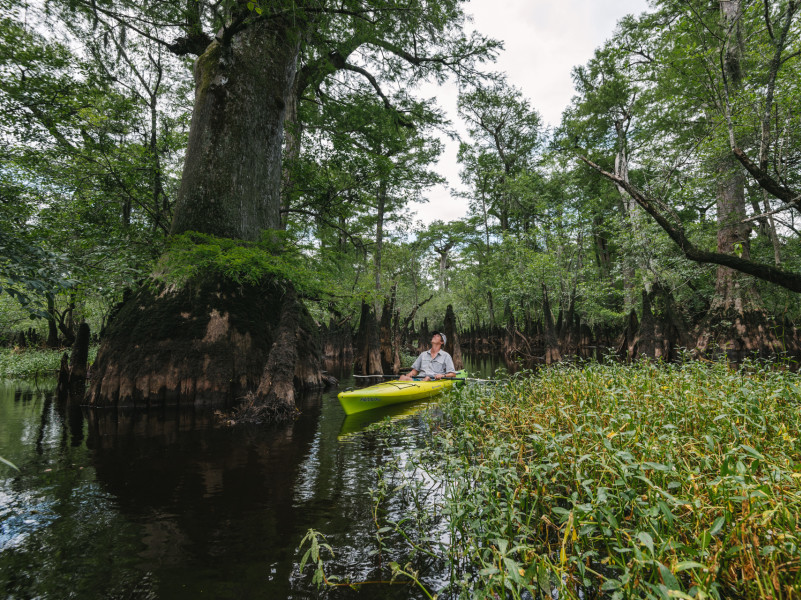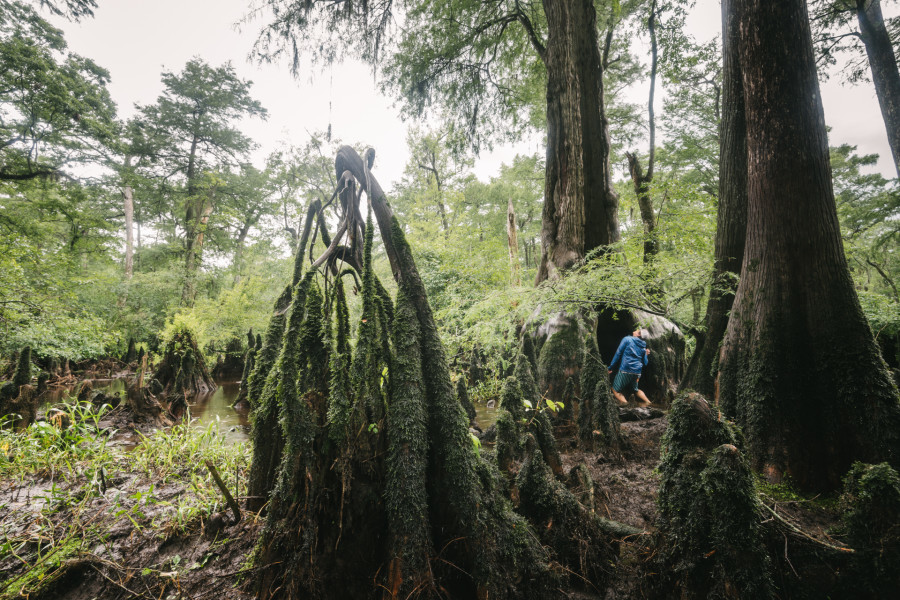
Black River, NC Photo: Andrew Kornylak
The Conservation Alliance awarded The Nature Conservancy in North Carolina a $40,000 grant in April 2017 to support the protection and restoration of old-growth bald cypress swamps and mature bottomland hardwoods along the Black River. The update is by Avery Lennard, Philanthropy and Communications Liaison at The Nature Conservancy.
In 1985, Dr. David Stahle from the University of Arkansas published a paper in Science with results of his dendrochronology work in the southeast United States. He sought out and cored old, solid cypress trees to study past climate patterns. His work helped him discover the oldest known tree in eastern North America – a cypress on the Black River that dates to before 364 A.D. Although they cannot be cored, researchers suspect there are hollowed trees on the river more than 2,000 years old.
Defying the Odds
The old-growth forest is incredible, perhaps most so because of its location. Much of southeastern United States was systematically logged in the 19th century, and yet somehow the Black River cypress remain standing. It may have been the difficulty of extracting trees from swampy areas along the river that deterred the logging companies.
Unfortunately, today’s shovel logging techniques can get into places formerly inaccessible. There is renewed danger that unprotected trees that have stood the test of time along the Black River and nearby streams could now fall victim to shovel logging.
Standing for Nature and People
The importance of the ancient cypress surpasses their age. The Black River is designated as an Outstanding Resource Water (ORW), the state’s highest water classification. The river offers exceptional and varied habitats, is home to a diverse array of aquatic life, and has excellent water quality. The lower stretch of the river is home to 5 rare mussel species tracked by the Natural Heritage Program, Atlantic Pigtoe (Fusconaia masoni), Cape Fear Spike (Elliptio marsupiobesa), Pod Lance (E. folliculata), Eastern Lampmussel (Lampsilis radiata) and Yellow Lampmussel (L. cariosa). The ancient cypress are part of the forest system that buffers the river, limiting nutrients and other pollutants from flowing into the water. This has become increasingly more important as large agricultural operations have moved into the area.
The trees also provide a source of income for nearby businesses. Not surprisingly, the Black River has become a well-known place for recreational boating, especially the lower portion where the old-growth cypress are concentrated. Paddlers from near and far regularly visit this stretch of river to witness the beauty of these forests and the wildlife they support. These visitors help build the local economy.
Protecting the Ancient
Recognizing the uniqueness of the old-growth forest and a need for action, The Nature Conservancy has been protecting land along the Black River since the early 1990s. The North Carolina Chapter has purchased more than 8,000 acres of land along the Black River and more than 8,000 acres of land on its tributaries, totaling more than 150 miles of stream frontage within the basin.
The Conservancy actively manages 2,835 acres of land along the river, known as the Black River Preserve. With the support of the Conservation Alliance, the Conservancy recently added 410 acres of land to the preserve. This land has a river access point known as Sparkleberry Landing. Having an access point on the river is a critical step towards opening the conserved land for public enjoyment.
What’s Next?
The protection of this tract marks the latest success in protecting almost all the old growth in a 13-mile stretch of the Black River and conserves more than 410 acres of old growth cypress swamp and bottomland hardwood forests, protects 9,750 feet of river footage, and supports a combination of riverfront and adjacent upland habitat for rare species. The Conservancy is restoring the upland portions of the property by planting longleaf pines and other naturally appropriate trees where needed and implementing a controlled burn program.
Local legislators recently recognized the importance of the Black River, introducing legislation to authorize the creation of Black River State Park. A feasibility study is currently underway to determine if it is possible and desirable to do so. The park would highlight the river’s ecology, history, conservation areas and paddle trail opportunities.
The Conservancy supports the creation of Black River State Park and anticipates transferring key pieces of restored property to the state if plans move forward. After all, paddling among ancient trees is an experience unlike any other in the world.



